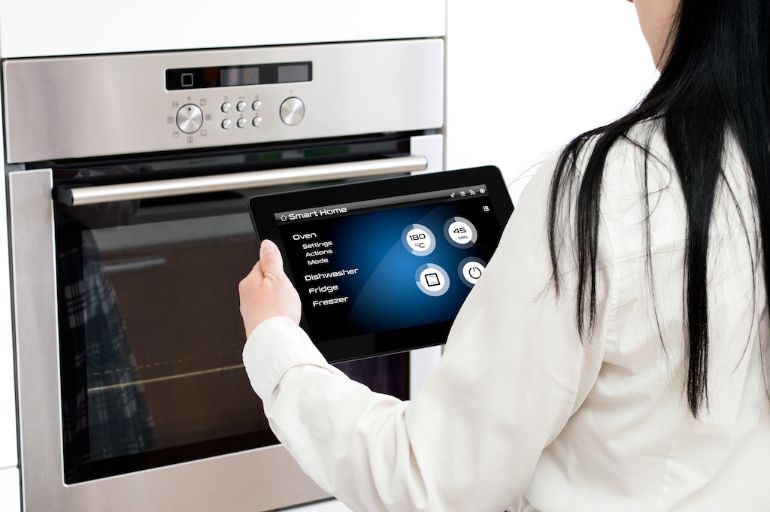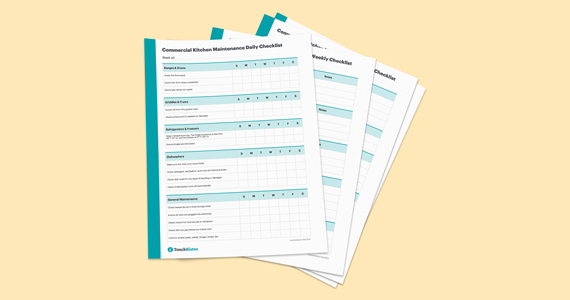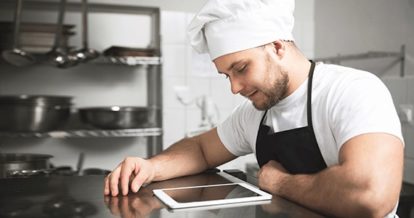Whether you’re considering opening a new restaurant or updating your existing restaurant’s kitchen, choosing the right appliances, tools, and equipment for your back of house is crucial for the long-term success of your business.
Beyond the purchase of the basic commercial kitchen equipment every restaurant needs, you should consider investing in some staple kitchen technology that can improve your kitchen workflow.
While high-tech kitchen equipment can be pricier than its old school alternatives, restaurant equipment financing, loans, and other funding options are always available. And thanks to innovations in restaurant technologies, your kitchen equipment can play double duty by improving food safety, automating repetitive tasks, and lowering labor costs.
Basically, restaurant kitchen tech lets you and your back-of-house team focus on what you do best: cook great food!
If you’re ready to invest in technology for your commercial kitchen, here’s where you should start.
1. Food Safety Management System
Food safety management systems help keep food inspectors happy and your customers healthy by streamlining food safety regulation compliance and paperwork.
Food safety management systems range from software and smartphone apps to fully connected networks of appliances that can automatically check key food safety indicators.
Here are some benefits to food safety management systems:
No more paperwork. With cloud technology replacing paperwork, this set of restaurant kitchen technology helps you better keep track of what your team inspected and when, without the risk of misplaced records.
Improved health inspection results. A good food safety management system will remind you when it’s time to inspect your kitchen’s food safety compliance with a digital checklist.
Decreased liability. Robust analytics and reporting through your food safety management system can protect your restaurant from food poisoning rumors. With meticulous record keeping made easy, you can easily show food inspectors that your ingredients and restaurant equipment list are up to standards, which can protect you from a lawsuit. A kitchen prep list template can also come in handy to help your staff stay organized and keep track of what ingredients they are preparing each day.
Here are some examples of food safety management systems:
- Checkit: suitable for restaurants in the U.S. and U.K. thanks to pre-loaded local compliance regulations. Checkit provides a digital monitoring interface, temperature probe, wireless automated monitoring, and a reporting dashboard.
- Navitas: devices that monitor the temperature of your fridge and freezer, a wireless temperature probe, and online reporting.
- Safefood 360°: robust software-only solutions that help you streamline food safety compliance by replacing pen-and-paper or Excel methods.
2. Internet of Things: A Remotely Controlled Kitchen
The Internet of Things (also known as IoT) is a network of physical appliances and devices that use a digital connection to communicate with each other.
Implemented in a commercial kitchen setting, Internet of Things technology can be used to create a smart, remotely controlled kitchen.
In an Internet of Things commercial kitchen, your refrigerator could track and reorder inventory on your behalf. But really, this is just one example of the endless applications and possibilities of an IoT kitchen. Here are some benefits to an IoT remotely controlled kitchen:
Lower labor costs. With a smart kitchen that can automate repetitive tasks such as monitoring appliances and tracking inventory, you can accomplish more with a smaller team.
Improved guest experience. Smart appliances that keep track of kitchen performance reduce human error and increase preparation consistency.
Peace of mind. With remote monitoring through the Internet of Things, you can keep track of your restaurant kitchen no matter where you are.
Unlike most of the kitchen technology we share in this article, a remotely controlled kitchen is not a pre-made product but a bespoke network. IoT providers can design and install an Internet of Things kitchen that’s right for your restaurant.
3. Kitchen Display System
A kitchen display system (KDS) is a must-have restaurant technology in any commercial kitchen – just ask Chef Jay Zheng of Koyo restaurant in New York City. Kitchen display systems replace old school kitchen receipt printers by improving communication between your front-of-house and back-of-house teams.
Here are some benefits to a kitchen display system:
No lag. With a digital kitchen order system, orders appear immediately on a monitor or tablet so your team doesn’t have to wait for a receipt to be printed.
Improved cooking time. Robust kitchen display systems can keep track of how long it takes your team to complete tickets. This data can help you manage your back-of-house team and make well-informed decisions about your menu.
TouchBistro’s Kitchen Display System is the industry-leading technology for back-of-house operations. TouchBistro’s KDS provides a consolidated view of all unprepared items across all open tickets. Whole individual tickets are color-coded based on how long they’ve been open, which makes managing the kitchen far easier for the expo or head chef.
4. Smart Oven

Food service equipment trends like smart appliances have led to cutting-edge commercial kitchen equipment like smart ovens. Consider equipping your restaurant kitchen with a cook and hold oven or smart combi oven to reduce labor costs by automating routine tasks.
Cook and hold oven
A cook and hold oven is the ultimate set-it-and-forget-it oven. This new technology in the restaurant industry can automatically lower itself to a holding temperature after cooking is complete so that the adjustment does not have to be made manually.
Here are some benefits to a cook and hold oven:
Reduced energy costs. Most cook and hold ovens use radiant heating technology, which creates an even heat that can cut down on your kitchen’s energy use.
Optimized kitchen space. Because a cook and hold oven can operate at a lower temperature than its traditional counterparts, you won’t need ventilation or a hood – which can save you precious space in your kitchen.
When choosing a cook and hold oven, consider factors like size, features, and heating method. Here are some examples of cook and hold ovens you may want to consider:
- Alto-Shaam: the original cook and hold ovens
- CVap by Winston Foodservice: a range of options for your commercial kitchen equipment needs

Use this kitchen equipment maintenance checklist to help extend equipment life, reduce utility consumption, and prevent unexpected breakdowns.
Smart combi oven
A smart combi oven is a three-in-one oven that can cook using convected heat, steam, or a combination of both. A smart combi oven adds another layer of technology to the appliance by offering the ability for remote control and monitoring.
Here are some benefits to a smart combi oven:
Space and money savings. A smart combi oven will save you money in the long run because you will need only one kind of oven for most of your baking needs. The multipurpose appliance will also take up less space than two single-purpose ovens would.
Increased food safety. Cutting edge smart combi oven can keep track of Hazard Analysis and Critical Control Points (HACCP), keeping your guests safe from the risk of food poisoning.
Reduced labor costs. Remote control of your oven means that you can have fewer staff members present in your kitchen at certain times.
Here are some vendors you may want to consider:
- RATIONAL’s SelfCookingCenter
- Alto-Shaam’s Combitherm Combi Oven
- Convotherm’s Convotherm 4 Combi Oven
While state-of-the-art restaurant technologies may cost more than their traditional counterparts at the outset, these tools quickly pay for themselves with the value they add to your restaurant. An investment in restaurant kitchen technology and keeping up with restaurant maintenance and restaurant kitchen cleaning will help you increase the safety of your kitchen, cut down on labor costs, and improve your guest experience.
Some food service equipment trends come and go as quickly as the cronut, while others, like remote controlled smart appliances and digital kitchen display systems, are here to stay. This new technology in the food service industry can set you and your restaurant up for success for years to come.
Get the Complete Guide to Restaurant Reservations
Sign up for our free weekly TouchBistro Newsletter







